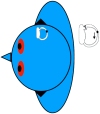Management of Lateral Semicircular Canal Benign Paroxysmal Positional Vertigo
- PMID: 33041982
- PMCID: PMC7522363
- DOI: 10.3389/fneur.2020.01040
Management of Lateral Semicircular Canal Benign Paroxysmal Positional Vertigo
Abstract
Benign paroxysmal positional vertigo (BPPV) is the most common cause of peripheral vestibular vertigo. It is caused by free-floating otoconia moving freely in one of the semicircular canals (canalolithiasis) or by otoliths adhered to the cupula (cupulolithiasis). The posterior canal is the most common canal affected, followed by the lateral canal. Diagnosis of the side affected is critical for successful treatment; therefore, suppressing visual fixation is essential to examination of these patients' eye movement. On the basis of our experience, we have adopted the Zuma maneuver and the modified Zuma maneuver for both apogeotropic and geotropic variants of lateral canal BPPV. Knowledge of the anatomy and pathophysiologic mechanisms of the semicircular canals is essential for correct management of these patients. Hence, using a single maneuver and its modification may facilitate daily neurotological practice.
Keywords: apogeotropic nystagmus; benign paroxysmal positional vertigo; canalolithiasis; cupulolithiasis; geotropic nystagmus; horizontal semicircular canal; lateral semicircular canal; repositioning maneuvers.
Copyright © 2020 Zuma e Maia, Ramos, Cal, Brock, Mangabeira Albernaz and Strupp.
Figures








Similar articles
-
Zuma Modified Maneuver as a Treatment to Geotropic Lateral Semicircular Canal Benign Paroxysmal Positional Vertigo.Int Arch Otorhinolaryngol. 2021 Apr;25(2):e255-e257. doi: 10.1055/s-0040-1712935. Epub 2020 Jun 23. Int Arch Otorhinolaryngol. 2021. PMID: 33968229 Free PMC article.
-
The role of the reversed nystagmus during Zuma maneuver in patients treated for geotropic lateral canal benign paroxysmal positional vertigo.J Neurol Sci. 2022 Mar 15;434:120160. doi: 10.1016/j.jns.2022.120160. Epub 2022 Jan 19. J Neurol Sci. 2022. PMID: 35077883
-
Direction-fixed paroxysmal nystagmus lateral canal benign paroxysmal positioning vertigo (BPPV): another form of lateral canalolithiasis.Acta Otorhinolaryngol Ital. 2013 Aug;33(4):254-60. Acta Otorhinolaryngol Ital. 2013. PMID: 24043913 Free PMC article.
-
Benign paroxysmal positional vertigo.Auris Nasus Larynx. 2022 Oct;49(5):737-747. doi: 10.1016/j.anl.2022.03.012. Epub 2022 Apr 3. Auris Nasus Larynx. 2022. PMID: 35387740 Review.
-
Classification, diagnostic criteria and management of benign paroxysmal positional vertigo.Auris Nasus Larynx. 2017 Feb;44(1):1-6. doi: 10.1016/j.anl.2016.03.013. Epub 2016 May 9. Auris Nasus Larynx. 2017. PMID: 27174206 Review.
Cited by
-
Rapid axial roll test outperforms alternative positional tests in identifying the affected ear in HSC-BPPV: an observational cohort study.Front Neurol. 2024 Jun 19;15:1432608. doi: 10.3389/fneur.2024.1432608. eCollection 2024. Front Neurol. 2024. PMID: 38962475 Free PMC article.
-
Direct Resolution of Horizontal Semicircular Cupulolithiasis by Zuma Plus Maneuver Vis-à-Vis Transformation to Canalolithiasis by Zuma Maneuver.Ann Indian Acad Neurol. 2024 Mar-Apr;27(2):203-205. doi: 10.4103/aian.aian_767_23. Epub 2024 Jan 18. Ann Indian Acad Neurol. 2024. PMID: 38751927 Free PMC article. No abstract available.
-
Atypical symptoms and delayed diagnosis are more common in elderly patients with benign paroxysmal positional vertigo: a single-center study.Front Neurol. 2025 Apr 24;16:1575816. doi: 10.3389/fneur.2025.1575816. eCollection 2025. Front Neurol. 2025. PMID: 40343180 Free PMC article.
-
Central positional nystagmus: an update.J Neurol. 2022 Apr;269(4):1851-1860. doi: 10.1007/s00415-021-10852-8. Epub 2021 Oct 20. J Neurol. 2022. PMID: 34669008 Review.
-
Prevalence of Horizontal Canal Variant in 3,975 Patients With Benign Paroxysmal Positional Vertigo: A Cross-sectional Study.Neurol Clin Pract. 2023 Oct;13(5):e200191. doi: 10.1212/CPJ.0000000000200191. Epub 2023 Aug 23. Neurol Clin Pract. 2023. PMID: 37664131 Free PMC article.
References
Publication types
LinkOut - more resources
Full Text Sources

